Using UAVs and Photogrammetry in Bathymetric Surveys in Shallow Waters
Abstract
:1. Introduction
Previous Works
2. Materials and Methods
2.1. Equipment Used
2.2. Methodology
2.2.1. Area Preparation
2.2.2. Data Collection
2.2.3. Data Processing
3. Results
Data Analysis
4. Conclusions
Author Contributions
Funding
Data Availability Statement
Acknowledgments
Conflicts of Interest
References
- Bergsma, E.W.J.; Almar, R.; Rolland, A.; Binet, R.; Brodie, K.L.; Bak, A.S. Coastal morphology from space: A showcase of monitoring the topography-bathymetry continuum. Remote Sens. Environ. 2021, 261, 112469. [Google Scholar] [CrossRef]
- Kearns, T.A.; Breman, J. Bathymetry—The Art and Science of Seafloor Modelling for Modern Applications. Ocean Globe 2010, 1–36. [Google Scholar]
- Kapustina, M.V.; Dorokhov, D.V.; Sivkov, V.V. Multibeam bathymetry data of the western part of the Romanche Trench (Equatorial Atlantic). Data Brief 2021, 37, 107198. [Google Scholar] [CrossRef] [PubMed]
- Li, Y.; Gao, H.; Zhao, G.; Tseng, K.H. A high-resolution bathymetry dataset for global reservoirs using multi-source satellite imagery and altimetry. Remote Sens. Environ. 2020, 244, 111831. [Google Scholar] [CrossRef]
- Ang, W.J.; Park, E.; Alcantara, E. Mapping floodplain bathymetry in the middle-lower Amazon River using inundation frequency and field control. Geomorphology 2021, 392, 107937. [Google Scholar] [CrossRef]
- Ballestero, M.; García, D. Estudio Batimétrico Con Ecosonda Multihaz y Clasificación de Fondos [A Bathymetric Study Using Multi Beam Echo Sounder and Background Classification]. Bachelor´s Thesis, Universidad Politécnica de Cataluña, Barcelonam, Spain, 2010. [Google Scholar]
- Bu, X.; Yang, F.; Xin, M.; Zhang, K.; Ma, Y. Improved calibration method for refraction errors in multibeam bathymetries with a wider range of water depths. Appl. Ocean Res. 2021, 114, 102778. [Google Scholar] [CrossRef]
- Fontán, A.; Albarracín, S.; Alcántara-Carrió, J. Estudios de erosión en costas sedimentarias mediante GPS diferencial y ecosonda monohaz/multihaz [Erosion Studies on Sedimentary Coasts Using Differential GPS and Single/Multi Beam Echo Sounders]. In Métodos en Teledetección Aplicada a la Prevención de Riesgos Naturales en el Litoral [Remote Sensing Methods Applied to the Prevention of Natural Risks on the Coast]; Programa Iberoamericano de Ciencia y Tecnología para el Desarrollo: Madrid, Spain, 2009; pp. 100–122. [Google Scholar]
- Dudkov, I.Y.; Sivkov, V.V.; Dorokhov, D.V.; Bashirova, L.D. Multibeam bathymetry data from the Kane Gap and south-eastern part of the Canary Basin (Eastern tropical Atlantic). Data Brief 2020, 32, 106055. [Google Scholar] [CrossRef]
- Sun, M.; Yu, L.; Zhang, P.; Sun, Q.; Jiao, X.; Sun, D.; Lun, F. Coastal water bathymetry for critical zone management using regression tree models from Gaofen-6 imagery. Ocean Coast. Manag. 2021, 204, 105522. [Google Scholar] [CrossRef]
- Westley, K. Satellite-derived bathymetry for maritime archaeology: Testing its effectiveness at two ancient harbours in the Eastern Mediterranean. J. Archaeol. Sci. Rep. 2021, 38, 103030. [Google Scholar] [CrossRef]
- Caballero, I.; Stumpf, R.P. Retrieval of nearshore bathymetry from Sentinel-2A and 2B satellites in South Florida coastal waters. Estuar. Coast. Shelf Sci. 2019, 226, 106277. [Google Scholar] [CrossRef]
- Schwarz, R.; Mandlburger, G.; Pfennigbauer, M.; Pfeifer, N. Design and evaluation of a full-wave surface and bottom-detection algorithm for LiDAR bathymetry of very shallow waters. ISPRS J. Photogramm. Remote Sens. 2019, 150, 1–10. [Google Scholar] [CrossRef]
- Specht, C.; Świtalski, E.; Specht, M. Application of an Autonomous/Unmanned Survey Vessel (ASV/USV) in Bathymetric Measurements. Pol. Marit. Res. 2017, 24, 36–44. [Google Scholar] [CrossRef] [Green Version]
- He, J.; Lin, J.; Ma, M.; Liao, X. Mapping topo-bathymetry of transparent tufa lakes using UAV-based photogrammetry and RGB imagery. Geomorphology 2021, 389, 107832. [Google Scholar] [CrossRef]
- Pan, Y.; Flindt, M.; Schneider-Kamp, P.; Holmer, M. Beach wrack mapping using unmanned aerial vehicles for coastal environmental management. Ocean Coast. Manag. 2021, 213, 105843. [Google Scholar] [CrossRef]
- Del Savio, A.A.; Luna-Torres, A.; Reyes-Ñique, J.L. Implementación del Uso de Drones en Mapeo Topográfico. [Implementing the Use of Drones in Topographic Mapping] Scientific Research Institute, Universidad de Lima. 2018. Available online: https://hdl.handle.net/20.500.12724/8111 (accessed on 20 December 2022).
- Alladi, T.; Bansal, G.; Chamola, V.; Guizani, M. SecAuthUAV: A novel authentication scheme for UAV-ground station and UAV-UAV communication. IEEE Trans. Veh. Technol. 2022, 69, 15068–15077. [Google Scholar] [CrossRef]
- Krichen, M.; Adoni, W.Y.H.; Mihoub, A.; Alzahrani, M.Y.; Nahhal, T. Security Challenges for Drone Communications: Possible Threats, Attacks and Countermeasures. In 2022 2nd International Conference of Smart Systems and Emerging Technologies (SMARTTECH); IEEE: Manhattan, NY, USA, 2022; pp. 184–189. [Google Scholar]
- Manzoor, S.; Liaghat, S.; Gustafson, A.; Johansson, D.; Schunnesson, H. Establishing relationships between structural data from close-range terrestrial digital photogrammetry and measurement while drilling data. Eng. Geol. 2020, 267, 105480. [Google Scholar] [CrossRef]
- Lavaquiol, B.; Sanz, R.; Llorens, J.; Arnó, J.; Escolà, A. A photogrammetry-based methodology to obtain accurate digital ground-truth of leafless fruit trees. Comput. Electron. Agric. 2021, 191, 106553. [Google Scholar] [CrossRef]
- Kardasz, P.; Doskocz, J.; Heejduk, M.; Wiejkut, P.; Zarzycki, H. Drones and Possibilities of Their Using. J. Civ. Environ. Eng. 2016, 6, 1–7. [Google Scholar] [CrossRef]
- Addo, K.A.; Jayson-Quashigah, P.N. UAV photogrammetry and 3D reconstruction: Application in coastal monitoring. Unmanned Aer. Syst. 2021, 157–174. [Google Scholar] [CrossRef]
- Dering, G.M.; Micklethwaite, S.; Thiele, S.T.; Vollgger, S.A.; Cruden, A.R. Review of drones, photogrammetry and emerging sensor technology for the study of dykes: Best practises and future potential. J. Volcanol. Geotherm. Res. 2019, 373, 148–166. [Google Scholar] [CrossRef]
- Elkhrachy, I. Accuracy Assessment of Low-Cost Unmanned Aerial Vehicle (UAV) Photogrammetry. Alex. Eng. J. 2021, 60, 5579–5590. [Google Scholar] [CrossRef]
- Jawak, S.D.; Vadlamani, S.S.; Luis, A.J. A Synoptic Review on Deriving Bathymetry Information Using Remote Sensing Technologies: Models, Methods and Comparisons. Adv. Remote Sens. 2015, 4, 147–162. [Google Scholar] [CrossRef] [Green Version]
- Watanabe, Y.; Kawahara, Y. UAV Photogrammetry for Monitoring Changes in River Topography and Vegetation. Procedia Eng. 2016, 154, 317–325. [Google Scholar] [CrossRef] [Green Version]
- Bandini, F.; Lopez-Tamayo, A.; Merediz-Alonso, G.; Olesen, D.H.; Jakobsen, J.; Wang, S.; Garcia, M.; Bauer-Gottwein, P. Unmanned aerial vehicle observations of water surface elevation and bathymetry in the cenotes and lagoons of the Yucatan Peninsula, Mexico. Hidrogeol. J. 2018, 26, 2213–2228. [Google Scholar] [CrossRef] [Green Version]
- Trujillo, A.; Thurman, H. Essentials of Oceanography, 10th ed.; Pearsons Education: Upper Saddle River, NJ, USA, 2010. [Google Scholar]
- Kieu, H.T.; Law, A.W.K. Remote sensing of coastal hydro-environment with portable unmanned aerial vehicles (pUAVs) a state-of-the-art review. J. Hydro-Environ. Res. 2021, 37, 32–45. [Google Scholar] [CrossRef]
- Erena, M.; Atenza, J.F.; García-Galiano, S.; Domínguez, J.A.; Bernabé, J.M. Use of drones for the topo-bathymetric monitoring of the reservoirs of the Segura River Basin. Water 2019, 11, 445. [Google Scholar] [CrossRef] [Green Version]
- Mosher, D.C.; Yanez-Carrizo, G. The elusive continental rise: Insights from residual bathymetry analysis of the Northwest Atlantic Margin. Earth-Sci. Rev. 2021, 217, 103608. [Google Scholar] [CrossRef]
- Pajares, G. Overview and Current Status of Remote Sensing Applications Based on Unmanned Aerial Vehicles (UAVs). Photogramm. Eng. Remote Sens. 2015, 81, 281–330. [Google Scholar] [CrossRef] [Green Version]
- Laborie, J.; Christiansen, F.; Beedholm, K.; Madsen, P.T.; Heerah, K. Behavioural impact assessment of unmanned aerial vehicles on Weddell seals (Leptonychotes weddellii). J. Exp. Mar. Biol. Ecol. 2021, 536, 151509. [Google Scholar] [CrossRef]
- Hodúl, M.; Bird, S.; Knudby, A.; Chénier, R. Satellite derived photogrammetric bathymetry. ISPRS J. Photogramm. Remote Sens. 2018, 142, 268–277. [Google Scholar] [CrossRef]
- Surisetty, V.V.A.K.; Venkateswarlu, C.; Gireesh, B.; Prasad, K.V.s.R.; Sharma, R. On improved nearshore bathymetry estimates from satellites using ensemble and machine learning approaches. Adv. Space Res. 2021, 68, 3342–3364. [Google Scholar] [CrossRef]
- Dietrich, J.T. Bathymetric Structure-from-Motion: Extracting shallow stream bathymetry from multi-view stereo photogrammetry. Earth Surf. Process. Landf. 2016, 42, 355–364. [Google Scholar] [CrossRef]
- Hodúl, M.; Chénier, R.; Faucher, M.A.; Ahola, R.; Knudby, A.; Bird, S. Photogrammetric Bathymetry for the Canadian Arctic. Marine Geodesy. 2019, 43, 23–43. [Google Scholar] [CrossRef] [Green Version]
- Cao, B.; Fang, Y.; Jiang, Z.; Gao, L.; Hu, H. Shallow water bathymetry from WorldView-2 stereo imagery using two-media photogrammetry. Eur. J. Remote Sens. 2019, 52, 506–521. [Google Scholar] [CrossRef] [Green Version]
- Chénier, R.; Faucher, M.A.; Ahola, R.; Shelat, Y.; Sagram, M. Bathymetric photogrammetry to update CHS charts: Comparing conventional 3D manual and automatic approaches. ISPRS Int. J. Geo-Inf. 2018, 7, 395. [Google Scholar] [CrossRef] [Green Version]
- Śledź, S.; Ewertowski, M.W.; Piekarczyk, J. Applications of unmanned aerial vehicle (UAV) surveys and Structure from Motion photogrammetry in glacial and periglacial geomorphology. Geomorphology 2021, 378, 107620. [Google Scholar] [CrossRef]
- Morris, C.; Weckler, P.; Arnall, B.; Alderman, P.; Kidd, J.; Sutherland, A. Weather Impacts on UAV Flight Availability for Agricultural Purposes in Oklahoma. In Proceedings of the 13th International Conference on Precision Agriculture, St. Louis, MO, USA, 31 July–3 August 2016. [Google Scholar]
- Alam, M.S.; Oluoch, J. A survey of safe landing zone detection techniques for autonomous unmanned aerial vehicles (UAVs). Expert Syst. Appl. 2021, 179, 115091. [Google Scholar] [CrossRef]
- Ismail, A.H.; AzmI, M.S.M.; Hashim, M.A.; Ayob, M.N.; Hashim, M.S.M.; Hassrizal, H.B. Development of a webcam based lux meter. In Proceedings of the IEEE Symposium on Computers and Informatics, ISCI 2013, Langkawi, Malaysia, 7–9 April 2013; pp. 70–74. [Google Scholar] [CrossRef]
- Garilli, E.; Bruno, N.; Autelitano, F.; Roncella, R.; Giuliani, F. Automatic detection of stone pavement’s pattern based on UAV photogrammetry. Autom. Constr. 2021, 122, 103477. [Google Scholar] [CrossRef]
- Skarlatos, D.; Agrafiotis, P. A Novel Iterative Water Refraction Correction Algorithm for Use in Structure from Motion Photogrammetric Pipeline. Mar. Sci. Eng. J. 2018, 6, 77. [Google Scholar] [CrossRef] [Green Version]
- Zhang, D.; Fang, T.; Ai, J.; Wang, Y.; Zhou, L.; Guo, J.; Mei, W.; Zhao, Y. UAV/RTS system based on MMCPF theory for fast and precise determination of position and orientation. Measurement 2022, 187, 110342. [Google Scholar] [CrossRef]
- Mason, D.; Davenport, I.; Robinson, G.; Flather, R.; Mccartney, B. Construction of an inter-tidal digital elevation model by the ‘water-line’ method. Geophys. Res. Lett. 1995, 22, 3187–3190. [Google Scholar] [CrossRef]
- Bandini, F.; Sunding, T.P.; Linde, J.; Smith, O.; Jensen, I.K.; Köppl, C.J.; Butts, M.; Bauer-Gottwein, P. Unmanned Aerial System (UAS) observations of water surface elevation in a small stream: Comparison of radar altimetry, lidar and photogrammetry techniques. Remote Sens. Environ. 2020, 237, 111487. [Google Scholar] [CrossRef]
- Furlan, L.M.; Moreira, C.A.; Alencar, P.G.; Rosolen, V. Environmental monitoring and hydrological simulations of a natural wetland based on high-resolution unmanned aerial vehicle data (Paulista Peripheral Depression, Brazil). Environ. Chall. 2021, 4, 100146. [Google Scholar] [CrossRef]
- Villarreal, C.A.; Garzón, C.G.; Mora, J.P.; Rojas, J.D.; Ríos, C.A. Workflow for capturing information and characterizing difficult-to-access geological outcrops using unmanned aerial vehicle-based digital photogrammetric data. J. Ind. Inf. Integr. 2021, 26, 100292. [Google Scholar] [CrossRef]
- Zhang, D.; Watson, R.; Dobie, G.; Macleod, C.; Khan, A.; Pierce, G. Quantifying impacts on remote photogrammetric inspection using unmanned aerial vehicles. Eng. Struct. 2020, 209, 109940. [Google Scholar] [CrossRef]
- Tao, X.; Li, Y.; Yan, W.; Wang, M.; Tan, Z.; Jiang, J.; Luan, Q. Heritable variation in tree growth and needle vegetation indices of slash pine (Pinus elliottii) using unmanned aerial vehicles (UAVs). Ind. Crops Prod. 2021, 173, 114073. [Google Scholar] [CrossRef]
- Kreij, A.; Scriffignano, J.; Rosendahl, D.; Nagel, T.; Ulm, S. Aboriginal stone-walled intertidal fishtrap morphology, function and chronology investigated with high-resolution close-range Unmanned Aerial Vehicle photogrammetry. J. Archaeol. Sci. 2018, 96, 148–161. [Google Scholar] [CrossRef]
- Ali-Sisto, D.; Gopalakrishnan, R.; Kukkonen, M.; Savolainen, P.; Packalen, P. A method for vertical adjustment of digital aerial photogrammetry data by using a high-quality digital terrain model. Int. J. Appl. Earth Obs. Geoinf. 2020, 84, 101954. [Google Scholar] [CrossRef]
- DJI Mavic 2 Specs. Available online: https://www.dji.com/mavic-2/info (accessed on 9 March 2020).
- Vellemu, E.C.; Katonda, V.; Yapuwa, H.; Msuku, G.; Nkhoma, S.; Makwakwa, C.; Safuya, K.; Maluwa, A. Using the Mavic 2 Pro drone for basic water quality assessment. Sci. Afr. 2021, 14, 00979. [Google Scholar] [CrossRef]
- Outay, F.; Mengash, H.A.; Adnan, M. Applications of unmanned aerial vehicle (UAV) in road safety, traffic and highway infrastructure management: Recent advances and challenges. Transp. Res. Part A Policy Pract. 2020, 141, 116–129. [Google Scholar] [CrossRef]
- Turbidímetro para Aguas TB 210 IR. Available online: https://giardinoperu.com/producto/tb-210-ir-lovibond (accessed on 9 March 2020).
- Amprobe LM-200LED LED Light Meter. Available online: http://content.amprobe.com/DataSheets/LM-200LED%20Light%20Meter.pdf (accessed on 9 March 2020).
- TOPCON Hiper VR GNSS Receiver. Available online: https://www.topconpositioning.com/es/support/products/hiper-vr (accessed on 20 October 2019).
- Ajayi, O.G.; Palmer, M.; Salubi, A.A. Modelling farmland topography for suitable site selection of dam construction using unmanned aerial vehicle (UAV) photogrammetry. Remote Sens. Appl. Soc. Environ. 2018, 11, 220–230. [Google Scholar] [CrossRef]
- Zolkepli, M.F.; Ishak, M.F.; Yunus, M.Y.M.; Zaini, M.S.I.; Wahap, M.S.; Yasin, A.M.; Sidik, M.H.; Hezmi, M.A. Application of unmanned aerial vehicle (UAV) for slope mapping at Pahang Matriculation College, Malaysia. Phys. Chem. Earth Parts A/B/C 2021, 123, 103003. [Google Scholar] [CrossRef]
- Pix4Dcapture. Available online: https://www.pix4d.com/es/producto/pix4dcapture (accessed on 19 August 2020).
- Song, L.; Marsh, T.L.; Voice, T.C.; Long, D.T. Loss of seasonal variability in a lake resulting from copper sulfate algaecide treatment. Phys. Chem. Earth Parts A/B/C 2011, 36, 430–435. [Google Scholar] [CrossRef]
- Meneses, N.C.; Baier, S.; Reidelstürz, P.; Geist, J.; Schneider, T. Modelling heights of sparse aquatic reed (Phragmites australis) using Structure from Motion point clouds derived from Rotary- and Fixed-Wing Unmanned Aerial Vehicle (UAV) data. Limnologica 2018, 72, 10–21. [Google Scholar] [CrossRef]
- Pix4Dmapper. Available online: https://www.pix4d.com/es/producto/pix4dmapper-fotogrametria-software (accessed on 19 August 2020).
- Mateus, S.; Sánchez, G.; Willian Branch, J.; Boulanger, P. Selección de puntos representativos en imágenes de rango. [Selection of Representative Points in Range Images]. Rev. Ing. Univ. De Medellín 2006, 5, 147–158. Available online: https://www.redalyc.org/articulo.oa?id=75050812 (accessed on 20 December 2022).
- Jeong, G.Y.; Nguyen, T.N.; Tran, D.K.; Hoang, T.B.H. Applying unmanned aerial vehicle photogrammetry for measuring dimension of structural elements in traditional timber building. Measurement 2020, 153, 107386. [Google Scholar] [CrossRef]
- Winkler, J. Snell’s Law 1 Optics. 2017. Available online: https://www.researchgate.net/publication/337486003_Snell%27s_Law_1_Optics?channel=doi&linkId=5ddb8f46a6fdccdb4462c979&showFulltext=true (accessed on 15 August 2021). [CrossRef]
- David, C.G.; Kohl, N.; Casella, E.; Rovere, A.; Ballesteros, P.; Schlurmann, T. Structure-from-Motion on shallow reefs and beaches: Potential and limitations of consumer-grade drones to reconstruct topography and bathymetry. Coral Reefs 2021, 40, 835–851. [Google Scholar] [CrossRef]
- Genchi, S.A.; Vitale, A.J.; Perillo, G.M.; Seitz, C.; Delrieux, C.A. Mapping Topobathymetry in a Shallow Tidal Environment Using Low-Cost Technology. Remote Sens. 2020, 12, 1394. [Google Scholar] [CrossRef]
- Murase, T.; Tanaka, M.; Tani, T.; Miyashita, Y.; Ohkawa, N.; Ishiguro, S.; Suzuki, Y.; Kayanne, H.; Yamano, H. A photogrammetric correction procedure for light refraction effects at a two-medium boundary. Photogramm. Eng. Remote Sens. 2008, 74, 1129–1136. [Google Scholar] [CrossRef]
- Agrafiotis, P.; Skarlatos, D.; Georgopoulos, A.; Karantzalos, K. Shallow water bathymetry mapping from UAV imagery based on machine learning. Int. Arch. Photogramm. Remote Sens. Spat. Inf. Sci. 2019, 2, 9–16. [Google Scholar] [CrossRef] [Green Version]
- Tellidis, I.; Levin, E. Photogrammetric image acquisition with small unmanned aerial systems. In Proceedings of the ASPRS 2014 Annual Conference, Louisville, KY, USA, 23–28 March 2014. [Google Scholar]
- Wang, B.H.; Wang, D.B.; Ali, Z.A.; Ting Ting, B.; Wang, H. An overview of various kinds of wind effects on unmanned aerial vehicle. Meas. Control 2019, 52, 731–739. [Google Scholar] [CrossRef] [Green Version]
- Del Savio, A.A.; Luna Torres, A.; Chicchón Apaza, M.A.; Vergara Olivera, M.A.; Llimpe Rojas, S.R.; Urday Ibarra, G.T.; Reyes Ñique, J.L.; Macedo Arevalo, R.I. Integrating a LiDAR Sensor in a UAV Platform to Obtain a Georeferenced Point Cloud. Appl. Sci. 2022, 12, 12838. [Google Scholar] [CrossRef]

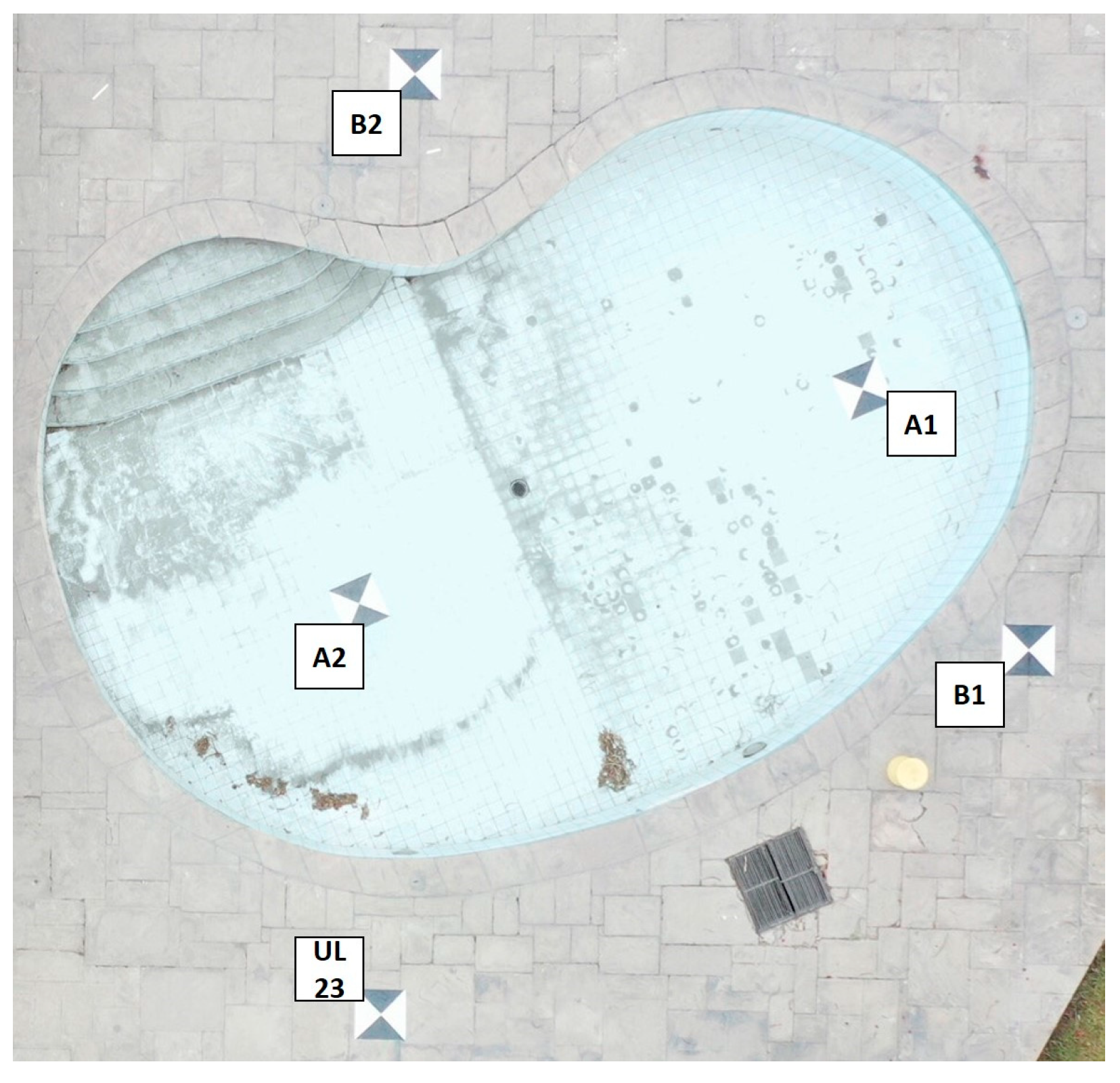
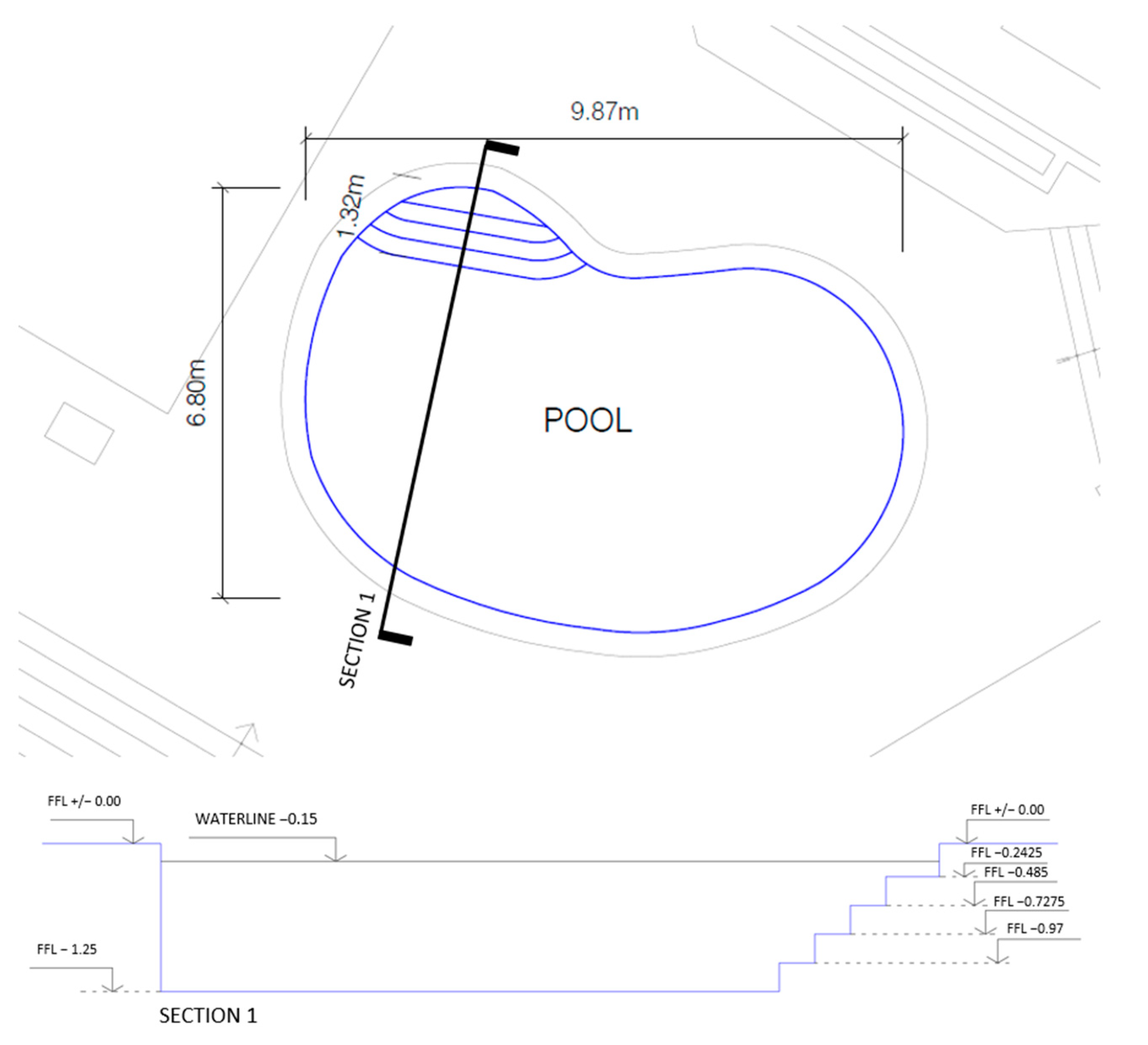


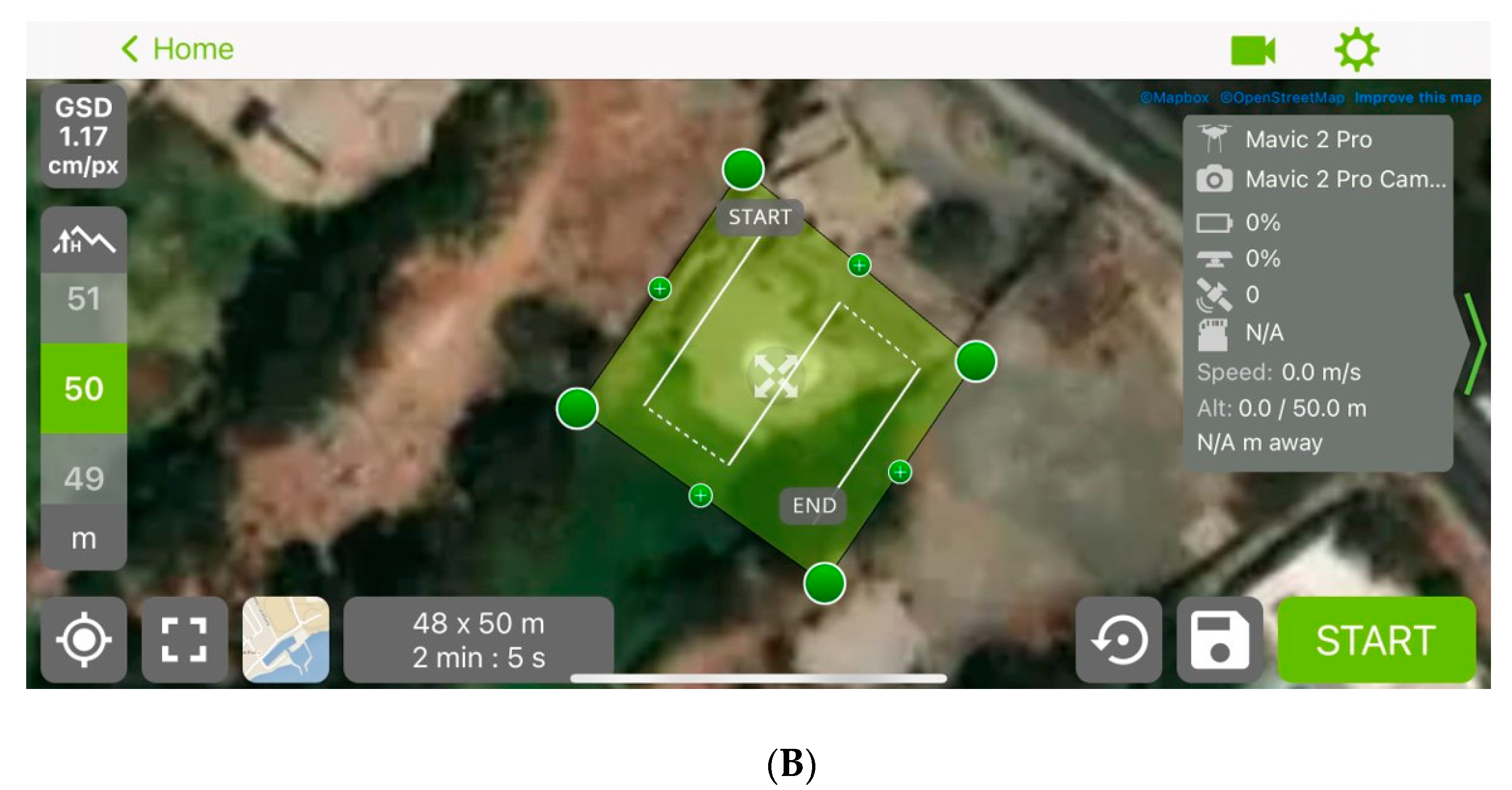

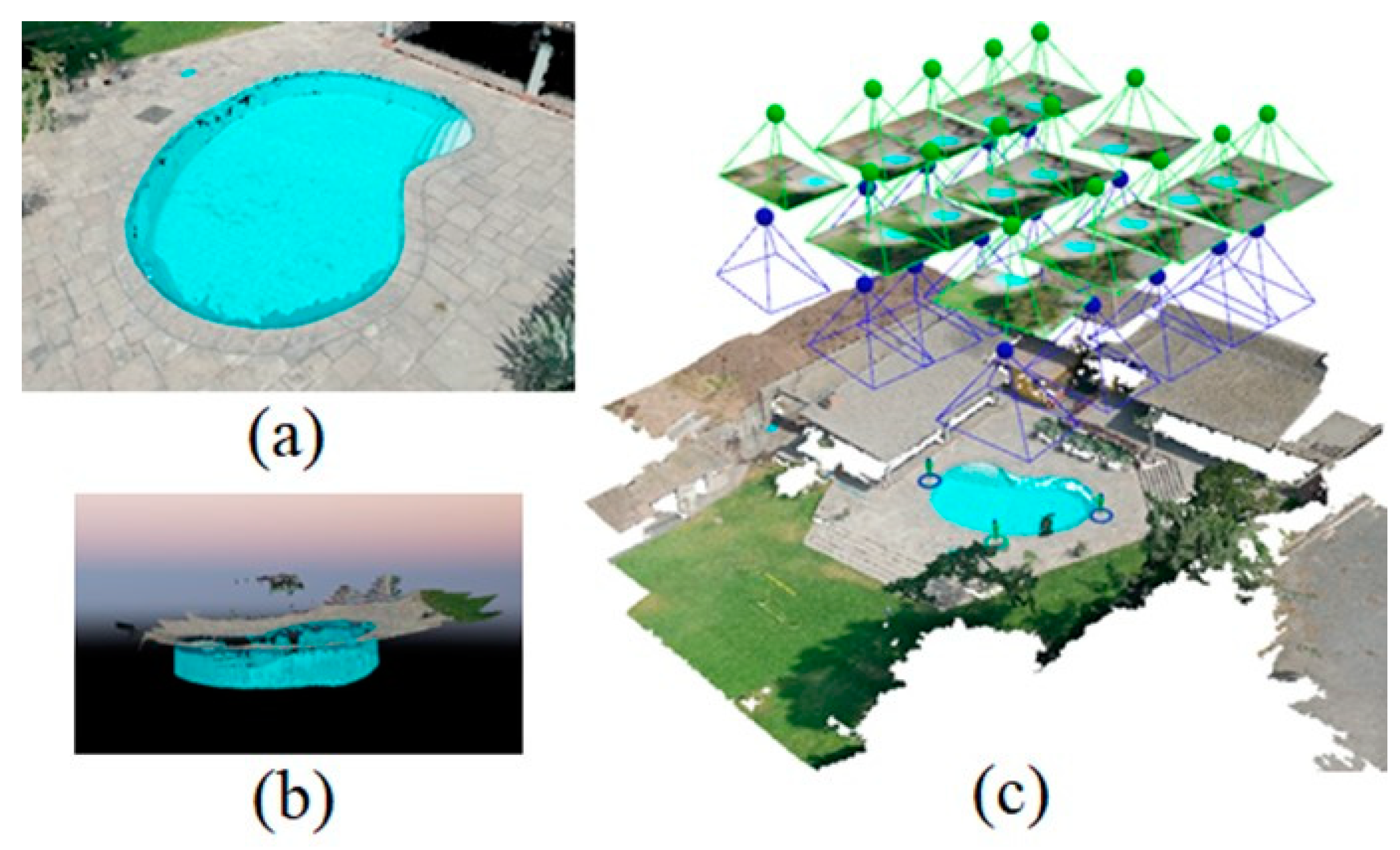
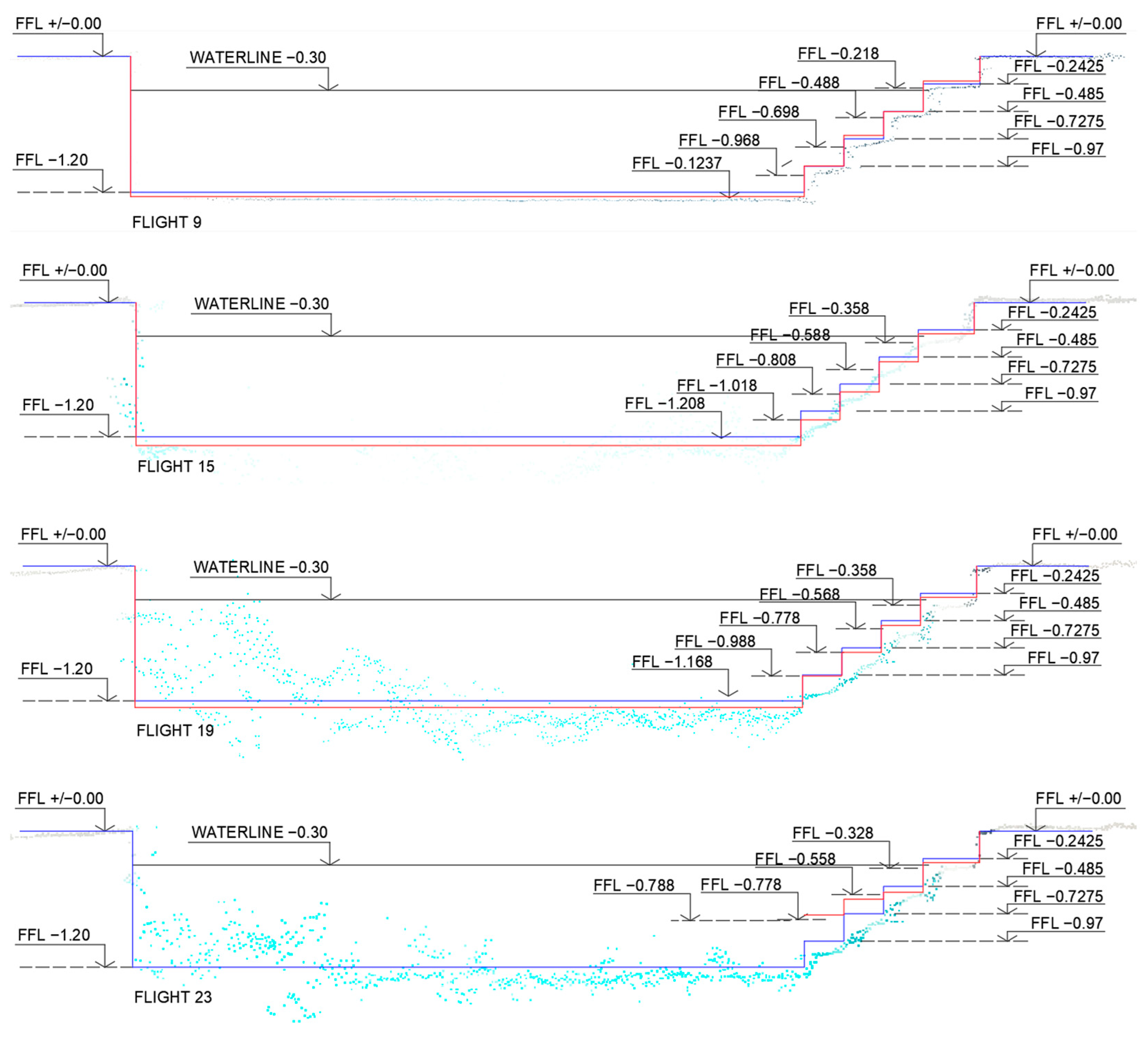
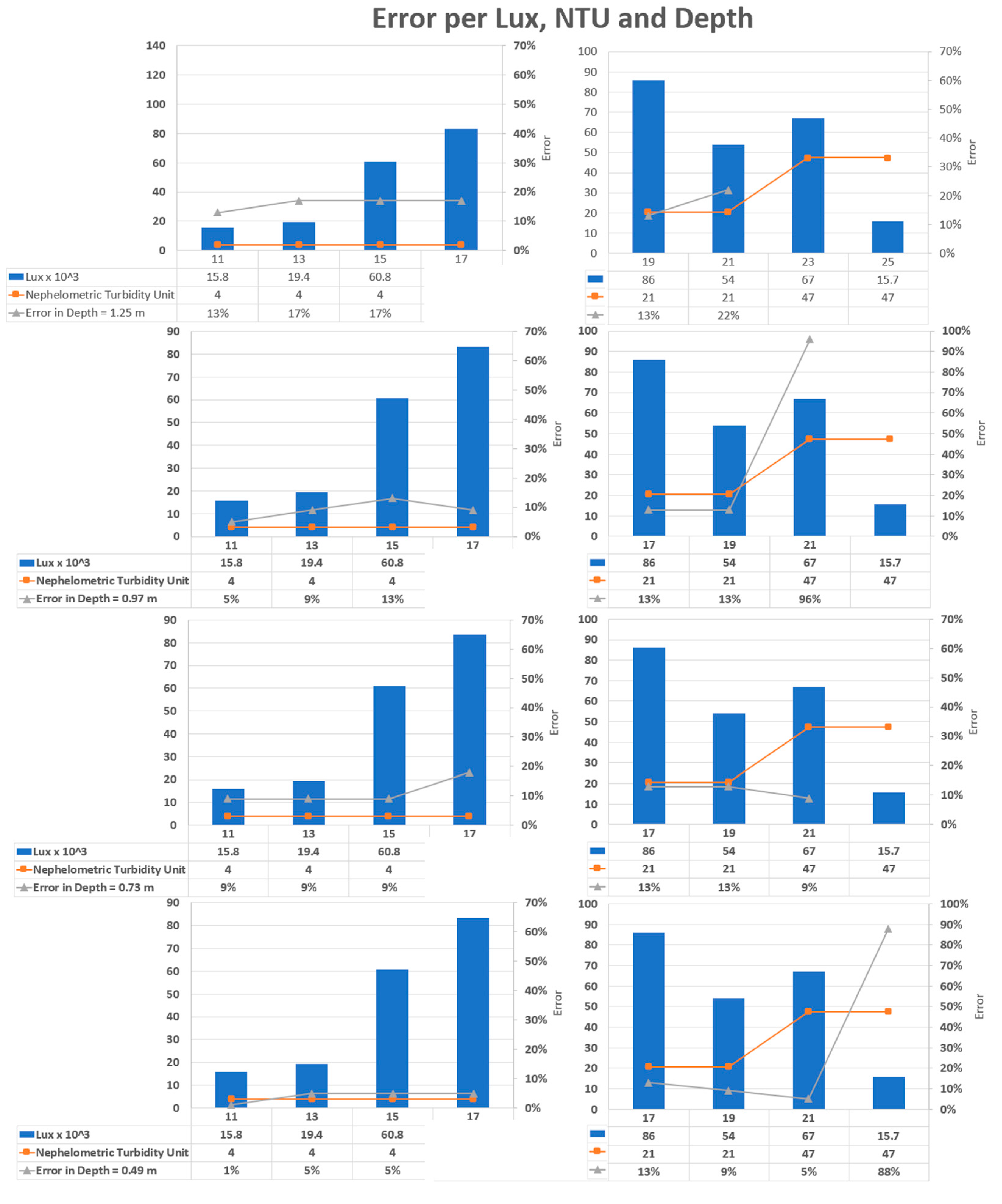
| Authors | Techniques | Sensor | Results | Precision |
|---|---|---|---|---|
| Erena et al. (2019) [27] | Photogrammetry | UAV | Topographic and bathymetric measurements for reservoirs | - |
| Hodúl et al. (2018) [33] | Photogrammetry (feature extraction and image geometry) | Satellite (WorldView-2) | Calculation of in-image depths | Mean error of 0.031 m and RMSE of 1.178 m |
| Surisetty et al. (2021) [34] | Log-ratio model (LRM) and log-linear model (LLM) | Sentinel-2 multi-spectral images | High-resolution bathymetry maps for coastal applications | Depths over 0–12 m LRM-Ens: 0.94 m LLM-Ens: 0.66 m LRM-SVR: 0.57 m LLM-SVR: 0.39 m |
| Dietrich (2016) [35] | Multi-view stereo photogrammetry | UAV | Point cloud | Accuracy of ~0.02% of the flying height Precision of ~0.1% of the flying height |
| Hodúl et al. (2019) [36] | Photogrammetry | Satellite (WorldView-2) | - | RMSE by study area: Coral Harbor: 0.78 m Cambridge Bay: 1.16 m Queen Maud Gulf: 0.97 m Arviat: 1.02 m Frobisher Bay: – – |
| Cao et al. (2019) [37] | Two-media photogrammetry | Satellite (WorldView-2) | Digital elevation model | RMSE: 5 m: 2.09 m 20 m: 1.76 m |
| Chénier et al. (2018) [38] | Automatic and 3D manual photogrammetry | Satellite | Improvement of CHS (Canadian Hydrographic Service) charts | RMSE: 10–12 m: 1.65 m (automatic) 10–12 m: 0.90 m (3D manual) |
| UAV Mavic 2 Pro [56] | ||
| Weight/maximum payload recommended | 734 g/743 g |  |
| Maximum flight time | 25 min | |
| Maximum ascent and descent speeds | 5 m/s and 3 m/s | |
| Satellite positioning system | GPS-GLONASS | |
| Camera | 20MP | |
| Battery life | 30 min | |
| Transmission distance | 8 km | |
| TB 210 IR Turbidity Meter [59] | ||
| Light source | Infrared LED (860 nm) |  |
| Accuracy | ±2.5% reading or ±0.01 NTU (whichever is greater) | |
| Handling | Acid and solvent-resistant polycarbonate membrane | |
| Suitable measuring cuvettes | Round 24 mm cuvettes | |
| Weight | 400 g | |
| Measurement range | 0.01–1.100 NTU | |
| Environmental conditions | 5–40 °C with a relative humidity of 30–90% | |
| LM-200LED Light Meter [60] | ||
| Measurement units | Lux or footcandle | 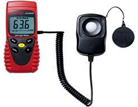 |
| Measurement range | 20,000 lux or 20,000 footcandle | |
| Battery | 9 V | |
| Accuracy | 3% | |
| External height/width/depth | 38 mm/63 mm/130 mm | |
| Hiper VR GNSS Receiver [64] | ||
| Channels | 226 | 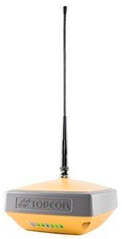 |
| Static | H: 3 mm + 0.4 ppm | |
| RTK | H: 5 mm + 0.5 ppm V: 10 mm + 0.8 ppm | |
| RTK, TILT Compensated | H: 1.3 mm/°Tilt; Tilt ≤ 10° H: 1.8 mm/°Tilt; Tilt ≤ 10° | |
| Operational time | RX mode, 10 h; TX mode 1 W, 6 h | |
| Internal radios | Max transmit power: 1 W; range: usually 5–7 km | |
| Memory | Internal nonremovable 8-GB SDHC | |
| Dimensions/weights | 150 mm3 × 100 mm3 × 150 mm3/<1.15 kg | |
| CP | X | Y | Z |
|---|---|---|---|
| A1 | 285,760.180 | 8,663,121.950 | 202.408 |
| A2i | 285,753.580 | 8,663,122.740 | 202.638 |
| B1 | 285,759.970 | 8,663,118.480 | 203.848 |
| B2 | 285,757.120 | 8,663,127.770 | 203.848 |
| UL23 | 285,751.352 | 8,663,118.494 | 203.848 |
| Selected Flight Parameters | |||||
|---|---|---|---|---|---|
| Flight | Start Time | Flight Height (m) | GSD (cm/px) | Camera Angle | Overlap |
| 1 | 7:53 | 30 | 0.70 | 90° | 80–75% |
| 2 | 7:58 | 50 | 1.17 | 90° | 80–75% |
| 3 | 10:41 | 30 | 0.70 | 90° | 80–75% |
| 4 | 10:46 | 50 | 1.17 | 90° | 80–75% |
| 5 | 14:10 | 30 | 0.70 | 90° | 80–75% |
| 6 | 14:13 | 50 | 1.17 | 90° | 80–75% |
| 7 | 7:35 | 30 | 0.70 | 90° | 80–75% |
| 8 | 7:39 | 50 | 1.17 | 90° | 80–75% |
| 9 | 14:33 | 30 | 0.70 | 90° | 80–75% |
| 10 | 14:37 | 50 | 1.17 | 90° | 80–75% |
| 11 | 15:39 | 30 | 0.70 | 90° | 80–75% |
| 12 | 15:44 | 50 | 1.17 | 90° | 80–75% |
| 13 | 10:36 | 30 | 0.70 | 90° | 80–75% |
| 14 | 10:40 | 50 | 1.17 | 90° | 80–75% |
| 15 | 14:23 | 30 | 0.70 | 90° | 80–75% |
| 16 | 14:26 | 50 | 1.17 | 90° | 80–75% |
| 17 | 11:40 | 30 | 0.70 | 90° | 80–75% |
| 18 | 11:40 | 50 | 1.17 | 90° | 80–75% |
| 19 | 12:10 | 30 | 0.70 | 90° | 80–75% |
| 20 | 12:10 | 50 | 1.17 | 90° | 80–75% |
| 21 | 14:27 | 30 | 0.70 | 90° | 80–75% |
| 22 | 14:30 | 50 | 1.17 | 90° | 80–75% |
| 23 | 14:45 | 30 | 0.70 | 90° | 80–75% |
| 24 | 14:48 | 50 | 1.17 | 90° | 80–75% |
| 25 | 8:38 | 30 | 0.70 | 90° | 80–75% |
| 26 | 8:41 | 50 | 1.17 | 90° | 80–75% |
| Selected Flight Parameters | |||||
|---|---|---|---|---|---|
| Flight | Reference Time | Turbidity (NTU) | Luminosity (lx) | Wind Speed (m/s) | Air Temperature (°C) |
| 1 | 7:53 | - | 3300 | 2 | 15 |
| 2 | 7:58 | - | 3500 | 2 | 15 |
| 3 | 10:41 | - | 24,800 | 2 | 17 |
| 4 | 10:46 | - | 23,200 | 2 | 17 |
| 5 | 14:10 | - | 21,200 | 2 | 19 |
| 6 | 14:13 | - | 20,600 | 2 | 19 |
| 7 | 7:35 | - | 2300 | 1 | 15 |
| 8 | 7:39 | - | 2600 | 1 | 15 |
| 9 | 14:33 | - | 71,200 | 3 | 18 |
| 10 | 14:37 | - | 69,500 | 3 | 18 |
| 11 | 15:39 | 4 | 15,800 | 2 | 16 |
| 12 | 15:44 | 4 | 15,400 | 2 | 16 |
| 13 | 10:36 | 4 | 19,400 | 2 | 15 |
| 14 | 10:40 | 4 | 20,100 | 2 | 15 |
| 15 | 14:23 | 4 | 60,800 | 2 | 18 |
| 16 | 14:26 | 4 | 60,300 | 2 | 18 |
| 17 | 11:40 | 4 | 83,400 | 2 | 17 |
| 18 | 11:40 | 4 | 86,700 | 2 | 17 |
| 19 | 12:10 | 20.54 | 86,000 | 2 | 18 |
| 20 | 12:10 | 20.54 | 86,500 | 2 | 18 |
| 21 | 14:27 | 20.54 | 54,000 | 2 | 18 |
| 22 | 14:30 | 20.54 | 66,500 | 2 | 18 |
| 23 | 14:45 | 47.41 | 67,000 | 2 | 18 |
| 24 | 14:48 | 47.41 | 66,000 | 2 | 18 |
| 25 | 8:38 | - | 15,700 | 2 | 16 |
| 26 | 8:41 | - | 13,600 | 2 | 16 |
| Flight | Accuracy for Control Point A1 (cm) | Accuracy for Control Point A2 (cm) | ||||
|---|---|---|---|---|---|---|
| X | Y | Z | X | Y | Z | |
| 1 | 0.005 | −0.004 | 0.009 | 0.000 | 0.011 | 0.047 |
| 3 | 0.009 | 0.002 | 0.032 | 0.002 | 0.008 | 0.061 |
| 5 | 0.002 | −0.006 | 0.050 | −0.007 | 0.014 | 0.108 |
| 7 | 0.005 | −0.002 | 0.011 | 0.003 | 0.009 | 0.046 |
| 9 | 0.009 | 0.001 | 0.002 | −0.003 | 0.016 | 0.048 |
| 11 | 0.020 | −0.010 | −0.022 | 0.010 | 0.050 | 0.038 |
| 13 | 0.010 | 0.000 | −0.072 | 0.020 | 0.020 | 0.008 |
| 15 | 0.010 | 0.000 | −0.072 | 0.010 | 0.010 | −0.002 |
| 17 | 0.000 | −0.010 | −0.092 | 0.010 | 0.000 | −0.012 |
| 19 | 0.040 | 0.000 | −0.152 | 0.000 | 0.040 | −0.052 |
| 21 | 0.040 | 0.000 | −0.132 | 0.000 | 0.030 | −0.042 |
| 23 | − | − | − | − | − | − |
| 25 | − | − | − | − | − | − |
| Average | 0.014 | −0.003 | −0.040 | 0.004 | 0.019 | 0.023 |
Disclaimer/Publisher’s Note: The statements, opinions and data contained in all publications are solely those of the individual author(s) and contributor(s) and not of MDPI and/or the editor(s). MDPI and/or the editor(s) disclaim responsibility for any injury to people or property resulting from any ideas, methods, instructions or products referred to in the content. |
© 2023 by the authors. Licensee MDPI, Basel, Switzerland. This article is an open access article distributed under the terms and conditions of the Creative Commons Attribution (CC BY) license (https://creativecommons.org/licenses/by/4.0/).
Share and Cite
Del Savio, A.A.; Luna Torres, A.; Vergara Olivera, M.A.; Llimpe Rojas, S.R.; Urday Ibarra, G.T.; Neckel, A. Using UAVs and Photogrammetry in Bathymetric Surveys in Shallow Waters. Appl. Sci. 2023, 13, 3420. https://doi.org/10.3390/app13063420
Del Savio AA, Luna Torres A, Vergara Olivera MA, Llimpe Rojas SR, Urday Ibarra GT, Neckel A. Using UAVs and Photogrammetry in Bathymetric Surveys in Shallow Waters. Applied Sciences. 2023; 13(6):3420. https://doi.org/10.3390/app13063420
Chicago/Turabian StyleDel Savio, Alexandre Almeida, Ana Luna Torres, Mónica Alejandra Vergara Olivera, Sara Rocio Llimpe Rojas, Gianella Tania Urday Ibarra, and Alcindo Neckel. 2023. "Using UAVs and Photogrammetry in Bathymetric Surveys in Shallow Waters" Applied Sciences 13, no. 6: 3420. https://doi.org/10.3390/app13063420







